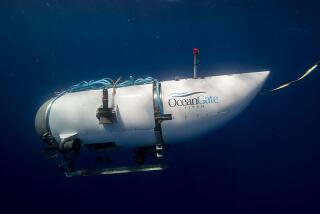Taking Risks to a Higher Threshold
- Share via
On the first day of this month, Robert Overacker powered a Jet Ski over Niagara Falls, hurtling with several million gallons of water per second down a 180-foot drop. Outfitted with signs reading “Save the Homeless” and a parachute engineered to release mid-jump--but not a life jacket--Overacker expected to drift to safety: a hero with a message. But the parachute failed to deploy and the 39-year-old Camarillo man died.
What possesses someone, even a trained stuntman like Overacker, to pursue such a feat? Excitement? Ego? Death wish?
Some psychologists say thrill seekers are wired differently than wimpier folk. Their biochemistry, urged on by environmental influences, fosters daredevil behavior. Thrill seekers not only have higher levels of testosterone (only men have been studied), but they also have lower levels of a brain chemical that regulates feelings of arousal and pleasure.
Other psychologists suggest that thrill seeking is a throwback to behavior essential to hunter-gatherers, who needed to slay woolly mammoths, cross precarious terrain and taste potentially poisonous plants to survive.
“High-sensation seekers” are more susceptible to boredom and thrive on change, says Marvin Zuckerman, author of “Behavioral Expressions and Biosocial Bases of Sensation Seeking,” (Cambridge University Press, 1994). Such people are perfectly aware of risks and usually plan to minimize the danger and avert death.
Studies of brain waves and the physiological responses to various stimuli found that thrill seekers--like people with manic disorders, antisocial individuals, criminals, and drug and alcohol abusers--had lower levels of monoamine oxidase (MAO), a brain enzyme responsible for regulating feelings of arousal and pleasure.
“It takes higher levels of arousal to arouse high-sensation seekers compared to low-sensation seekers,” Zuckerman says. “We found that norepinephrine [the brain’s version of adrenaline] also exists in lower levels in high-sensation seekers.
“A common expression [of sensation seeking] is in the way people drive their cars. High-sensation seekers were the closest tailgaters [in a 1992 Dutch study]. They did not perceive tailgating as risky. Low-sensation seekers experienced a three-fold heart-rate increase when they were asked to tailgate.”
MAO levels increase with age, says Zuckerman, which may help explain the decrease in thrill-seeking behavior as people mature. Or, as Jan Reynolds, who is 39 and a former biathlete who holds several high-altitude skiing / climbing records, circumnavigated Mt. Everest and attempted to fly a hot-air balloon over the peak (but crashed), says: You slow down so that you can keep doing “this boom-bah adventure stuff into your 90s.”
*
Urban risks aside, 20th-Century life offers mostly petit thrills: horror movies, blind dates, perfect cafe lattes and coups d’etat by ants in your kitchen. But for the big thrills, and especially for high-thrill seekers, people have to go to extreme measures to jolt those adrenals.
“It’s increasingly difficult to bring danger and excitement into your life,” says Michael J. Apter, author of “Dangerous Edge: Psychology of Excitement” (Free Press, 1992). “The American frontier is gone, fighting wars is increasingly technological and we are living in a nursemaid society, where we are always being told how to take care of ourselves.”
Risk taking is more than a behavior trait, argues Frank Farley, a University of Wisconsin psychology professor who coined the term “Type-T” (thrill seekers). It’s an American tradition.
“That is what draws many immigrants to America,” Farley says. “We are a Type-T country that values risk-taking, a free-market economy and entrepreneurship. The new [extreme] sports of America are much more thrilling and excitement oriented, with more individuality. Sky-surfing, jumping out of airplanes and street lugeing, where you go about 60 or 70 m.p.h. in a luge, are very dangerous.
“Some think people shouldn’t be allowed to go over Niagara Falls or engage in extreme sports. But if we [restrict] that, we run the risk of choking off that creative edge that comes with being able to roam the range of T-continuum.”
The real power of thrill seeking or adventure lies in its ability to transcend us, says Cal State Long Beach sociologist James William Gibson, author of “Warrior Dreams: Paramilitary Culture in Post-Vietnam America” (Hill and Wang, 1993), a book about men trying to satisfy their inner warrior in a warless culture.
“Adventure almost always involves a joint mind / body experience,” Gibson says. “It allows you to reinvent yourself. The question is: Does there have to be the risk of blood sacrifice to make it an adventure?”
No, says Steven Trotter, a Florida bartender who has gone over Niagara Falls in a barrel--twice.
“I am afraid of dying and I wouldn’t do something if it wasn’t engineered properly to be safe,” says Trotter, 33, whose second time over the falls was last summer with Lori Martin. He was jailed on $10,000 bail for 12 days.
“I do it because it is the biggest adrenaline rush. It’s heavy duty. It’s like AHHHHHH! AHHHHHH! The first time is the best.”





